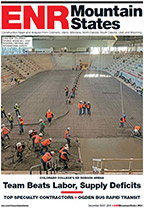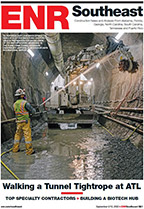From office buildings to sports arenas to subway stations and movie studios, family-owned E-J Electric Installation has consistently added to its portfolio of services and projects. Such scope and flexibility have helped the firm maintain a position for years among the top firms in ENR New York's annual specialty contractor ranking, and that diversity was especially helpful for the firm in the aftermath of Superstorm Sandy last October.
In fact, repairing and reconstructing New York buildings that Sandy had flooded with several feet of seawater, destroying their power systems, was a chief reason that E-J's 2012 revenue soared a hefty 65% to $305 million, compared with its more typical single-digit, year-on-year growth, executives at the firm say.
The Long Island City, Queens-based company has a staff of 850 field employees, which includes 35 engineers, far more than its rivals, according to clients and others who have worked with the firm, says J. Robert "Bob" Mann Jr., E-J chairman. These engineers tend to work closely with project managers in the field, a fact that allows projects to get done on time and efficiently, he says.
For these and other accomplishments, ENR regional editors have named E-J as ENR New York's Specialty Contractor of the Year.
A 114-year-old firm formed in the early years of electricity, E-J takes its name from the initials of its two founders, Jack Enright and Theodore Joseph. In 1912, they were joined by Jacques Mann, the father of Bob Mann, and the grandfather of the current chief executive, Tony Mann.
The business maintains its intergenerational management approach: Bob, who joined E-J in 1953, handles marketing, legal and financial issues as well as customer relations, while Tony takes care of day-to-day operations at the company, which is believed to be the oldest of its type in the country.
Many early clients included entertainment venues, like Long Island City's Paramount Astoria movie studio. Now known as the Kaufman Astoria Studios, the complex is still used for movie shoots, although it is no longer an E-J client.
But the firm is so old, diverse and big that many of its current and former projects can be seen throughout the city. "When I drive around New York, my kids always say, 'There goes Dad again, pointing at all our projects,'" says Tony Mann. Bob adds, "I think I did the same thing myself."
The venerable laundry list of work that has kept the firm busy includes the Sony Building, Rockefeller University and the Ed Sullivan Theater, in its David Letterman incarnation. It also includes scores of trading floors, water treatment plants and houses of worship in and around the metro area.
Its recent work includes a project that perhaps earned the firm the most acclaim: the completion last fall of the electrical work on the $485-million Barclays Center. Tony Mann says that the teams were up against a hard deadline in building the 670,000-sq-ft, 18,000-seat Brooklyn arena and they met it in time for Jay-Z to inaugurate the performance space with a concert last September.
On the job since 2009 and part of the original design-build team with Hunt Construction Group (despite architect changes), E-J added LED lights, video screens and the bulbs that glow from within the building's weathered-steel shell as well as pavers in its wide plaza. "A lot of that was done in the 11th hour in the weeks before the building opened," said Linda Chiarelli, the deputy director of construction for developer Forest City Ratner Co.
But there was just as much pressure on the front end too. Grounding grids, which were necessary so that circuit-breakers don't blow, and underground duct banks needed to be installed before most work could commence.
In a separate phase of the project, E-J helped relocate the rail yards at the Atlantic Yards site, used by Long Island Rail Road trains that once bisected the property. Four tracks in all were moved to make way for both the arena and a platform on which apartment towers are eventually slated to be built. E-J also helped to create a subway entrance, located by the oculus of Barclays Center, and to rebuild the Carlton Avenue bridge.
Chiarelli says that, besides being able to tackle a project of this scope, E-J gets points for being flexible during major design changes, which occurred after the architecture firm Ellerbe Beckett was replaced by SHoP Architects.
"Their strength is their capacity to be able to handle projects of this order of magnitude," said Chiarelli, whose firm has worked with E-J before. Repeat customers make up 60 percent of E-J's client base.
Other E-J projects that have been completed recently or are under way include the installation of a new cogeneration plant at Columbia University's campus in Manhattanville. The firm also worked on Boston Properties' 250 West 55th St. project. The 1-million-sq-ft, 38-story office building is set to open this winter.
Meanwhile, E-J had been building a cogen plant at the NYU Langone Medical Center last fall when Sandy hit and sent water into the center's East Side basements. Though that project wasn't affected, E-J was part of the emergency response team that worked to get the lights back on in the hospital, a feat that required round-the-clock work over three weeks by 100 employees, while at the same time trying to find someone to manufacture new switches.
"Our people were coming in their jeans on the weekend and sitting with the client to get them up safely and quickly," Tony Mann says. Other Sandy-repair-related business came from the Chelsea Piers sports complex; the Coler-Goldwater hospital on Roosevelt Island; and Four New York Plaza in the financial district, a project that included installing a temporary chiller and is still a work-in-progress, as electrical systems continue to be relocated to upper floors.
The firm has also increased business by diversifying. In 2007, it launched a transit division, which is now working on two local subway projects, for the No. 7 train and Second Avenue tunnels as well as the Fulton Center, the financial district subway hub.
Three years ago, E-J created a roadway division that has already refurbished the lights and conduit systems on Grand Central Parkway in Queens. It also has a contract to maintain electronic traffic signs citywide. About the only type of work that it is not interested in is residential projects, Tony Mann says.
In safety, the company attributes its good record to requiring daily safety reports of staff and other "simple steps." The firm has "a culture that wants everybody to go home the same way they started their day," says Bobby McCloskey, safety director. There are weekly safety meetings at jobsites and manager discussions with Tony Mann at monthly safety committee meetings.
Beginning last year, the firm requires its foremen to take a 30-hour OSHA safety course, taught by an in-house instructor, he says. Also, 700 employees must now wear safety gloves. The gloves cost a total of $3,000, and workers must start wearing them this month. "There is an extra cost, yes, but it's the cost of doing business safely," McCloskey says.
E-J encourages work with minority- and women-owned businesses, Tony Mann says. On the Columbia project, for example, it hired Egg Electric, a Manhattan-based, woman-owned business that it has used before.
He adds that the firm also prides itself on community outreach. Every year since 2008, for example, it raises money for the Jewish Board of Family and Children's Services with a bike ride through Westchester County. He says $700,000 was raised last year.












Post a comment to this article
Report Abusive Comment